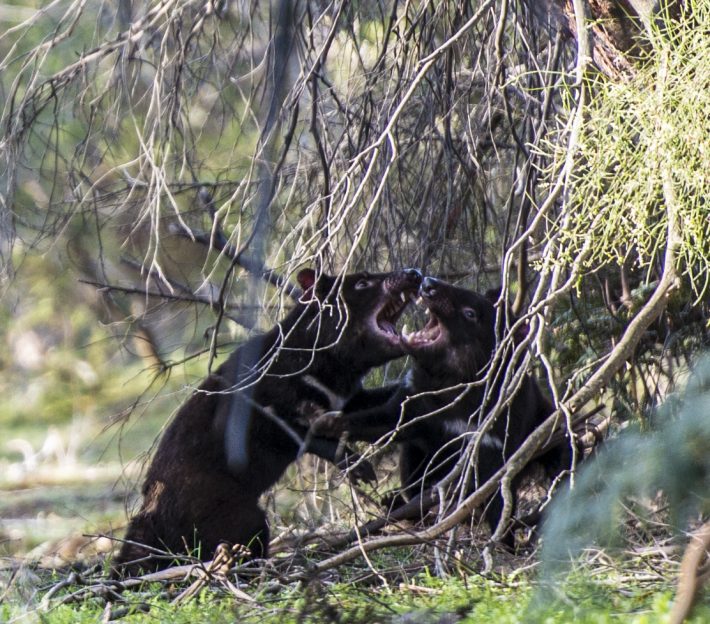The long-term impacts of devil facial tumour are revealed
Tasmanian Government press release
Ongoing monitoring of wild Tasmanian devils have shown that overall numbers are declining however to-date they have persisted in the wild.
The research paper “Density trends and demographic signals uncover the long-term impact of transmissible cancer in Tasmanian devils” has just been published in the Journal of Applied Ecology.

The monitoring research was conducted by the Save the Tasmanian Devil Program (STDP) in collaboration with staff from the Department of Primary Industries, Parks, Water and Environment (DPIPWE), San Diego Zoo Global, Toledo Zoo and the University of Tasmania.
Wildlife biologist with the STDP and lead author Dr Billie Lazenby said that the results of this research shows that devil densities at monitoring sites together with spotlight counts around the State have decreased by around 80 percent in diseased areas following the emergence of devil facial tumour disease (DFTD).
“While the number of Tasmanian devils in the wild continues to decline and DFTD is spreading, to date devils are still found in the wild in Tasmania,” she said. “We are now dealing with very small and potentially isolated groups of devils across Tasmania. The ongoing impact of DFTD, which continues to cause high mortality in devils, could make them vulnerable to other threats”.
“Devils in diseased areas are now breeding younger and having more pouch young, which has allowed them to persist at low levels in the wild.
“This research has shown the structure of the wild devil populations in diseased areas has shifted dramatically, with devils over the age of two being very rare compared to sites before DFTD emerged. Earlier breeding in young devils means that they are contracting DFTD younger, often as one year olds.”
STDP Program Manager and senior author Dr David Pemberton said while devils have persisted to date in the wild, such large reductions in their numbers and the change in their age structure means their populations are impacted more by other threats such as roadkill, bushfire, loss of genetic diversity, variation in food availability caused by drought, and changes in the ecosystem as it responds to the loss of devils in the wild.
“Efforts to manage the devils, such as the development of an immunotherapy are ongoing, but remain in a research and development phase.
“This means that recovery efforts focus on maintaining the small populations that have persisted,” he explained. “The STDP is addressing this by reducing the incidence of devil roadkill in known blackspot areas, and augmenting devil numbers, age structure, and genetic diversity by translocating devils into the wild.
Dr Lazenby said “This research gives an important insight into the monitoring of threatened species in the wild and its subsequent publication by the Journal of Applied Ecology means the STDP’s insights are now being shared with researchers and conservation managers around the world”.
Read the full article (freely available for a limited time):
Lazenby B, Tobler M, Brown B, et al. Fine scale density trends and demographic signals uncover the long-term impact of devil facial tumour disease. J Applied Ecol 2018. DOI: 10.1111/1365-2664.13088
Media contact:
Media Office, Department of Primary Industries, Parks, Water and Environment, Tasmanian Government, Email: communications.unit@dpac.tas.gov.au
Like what we stand for?
Support our mission and help develop the next generation of ecologists by donating to the British Ecological Society.